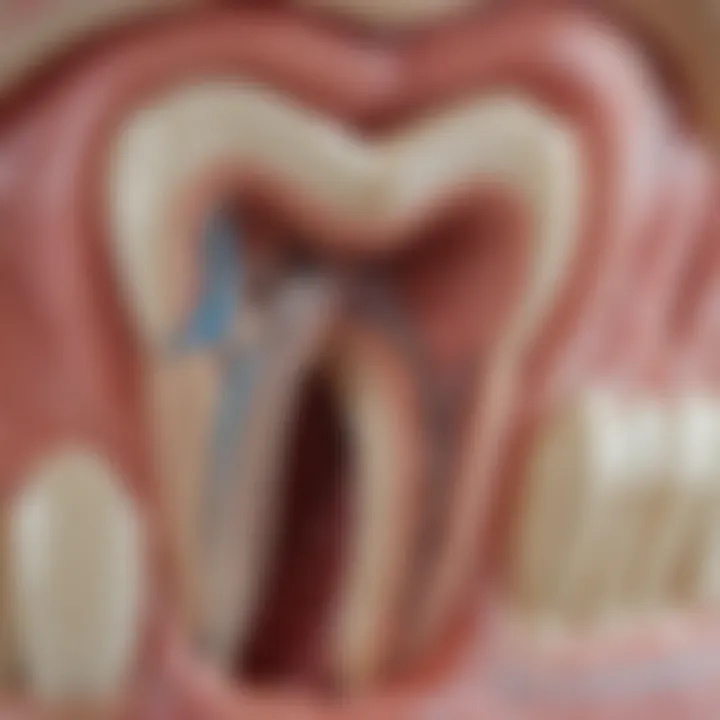Avulsed Teeth: Causes, Management, and Insights


Intro
Tooth avulsion, the complete displacement of a tooth from its socket, is a shocking event that can occur due to various reasons like trauma or accidents. Picture a child playing soccer, and in a split second, a hard collision leaves them in distress with a tooth lying on the ground. Understanding the implications of an avulsed tooth is crucial not only for dental professionals but also for individuals who may find themselves in such a predicament. This article seeks to unravel the complexities of dental avulsion, exploring essential factors including its causes, immediate responses, and long-term consequences.
The significance of grasping this topic extends beyond just emergency situations; it encompasses the subsequent treatment and psychological ramifications faced by both the patient and the caregiver.
Research Overview
Summary of Key Findings
Research indicates that timely intervention can greatly influence the success of tooth re-implantation. Factors such as the age of the patient, the type of tooth lost, and how the tooth was preserved before treatment play significant roles. For instance, studies reveal that a tooth stored in a suitable medium (such as cold milk or saline) tends to have a higher survival rate compared to one left exposed to air. Other findings point towards the anatomical integrity of the periodontal tissue as a predictor for successful reintegration.
Importance of the Research
Understanding avulsed teeth and their management is vital in multiple dimensions. Not only does it arm dental professionals with the knowledge necessary for immediate care, but it also prepares parents, educators, and coaches to respond adequately in emergencies. This preparedness could mean the difference between a successful re-implantation and tooth loss, underscoring the importance of spreading awareness concerning oral health emergencies.
Methodology
Study Design
The approach to studying tooth avulsion must combine both quantitative and qualitative methods. By examining statistical data on avulsion incidents, alongside interviews with dental professionals, we get a multi-faceted understanding of this dental emergency. Taking into account various demographics and incidents leads to more tailored approaches in management and prevention strategies.
Data Collection Techniques
Data collection involves surveys and questionnaires distributed among dental practitioners, as well as observations in emergency situations. These practice-based insights not only contribute to statistical analysis but also lead to practical guidelines that can improve emergency responses. Additionally, reviewing case studies from dental hospitals provides valuable context to contemporary practices and insights into the evolving landscape of dental technology.
"Immediate action can be the saving grace for an avulsed tooth. The quicker the response, the higher the chances of success in re-implantation."
Preface to Avulsed Teeth
Understanding avulsed teeth is essential, not only for dental professionals but also for patients and individuals in general. The act of losing a tooth due to avulsion is not merely a dental inconvenience; it carries varying implications on one’s health, self-image, and overall well-being. This section serves to highlight some crucial elements that encapsulate the importance of this subject, outlining the necessary considerations and practical benefits for both prevention and management.
Definition and Classification
To approach the topic effectively, one must first understand what tooth avulsion entails. It is defined simply as the complete displacement of a tooth out of its socket in the alveolar bone. This condition can arise from various factors, including traumatic incidents such as accidents or sports injuries, and it is classified generally into two categories: dental avulsions in children and those in adults.
When considering the age-specific classifications, it's notable that children frequently experience tooth avulsions due to their active lifestyles and underdeveloped coordination. Adults, on the other hand, often face such dental emergencies due to accidents or external forces like fights and falls. In both age groups, swift and effective response strategies are vital to increase the chances of retaining the tooth successfully.
Prevalence of Tooth Avulsion
The prevalence of tooth avulsion varies globally and across populations, with certain environments and activities posing higher risks. According to various studies, dental avulsion is most frequently observed in the adolescent demographic, particularly among those engaged in sports like basketball, soccer, and skateboarding. The American Academy of Pediatric Dentistry notes significant avulsion cases annually, pointing to a general lack of awareness regarding preventive measures.
"Knowledge of preventive steps can vastly decrease the incidence of dental avulsion, ultimately safeguarding both dental and general health."
The necessity of education and awareness cannot be overstated. Communities that actively promote the use of protective gear, such as mouthguards in sports, tend to report lower instances of avulsion-related injuries. Moreover, understanding the risk factors associated with this phenomenon helps tailor more effective interventions, encouraging a proactive approach to dental safety in schools and recreational settings.
In summary, grasping the significance of avulsed teeth is a pivotal step in not only managing the immediate responses but also shaping preventive strategies. By diving into the complexities of tooth avulsion's definition, classification, and prevalence, one can better appreciate the need for prompt action and comprehensive care planning.
This understanding ultimately bridges the gap between theoretical knowledge and practical application, ensuring we are prepared to tackle these unexpected incidents with more than just a reactionary mindset.
Anatomy of the Tooth Structure
Understanding the anatomy of tooth structure is fundamental for grasping how avulsion can affect dental health. A thorough comprehension of how teeth are constructed reveals the vulnerabilities they possess, alongside how they function and interact with surrounding tissues. The components of a tooth provide context that informs both preventative measures and recovery strategies when a tooth is lost.
Components of a Tooth
Teeth are not just simple, solid structures. They’re intricate and composed of several key parts:
- Enamel: The hard, outer layer of the tooth. It serves as the primary defense against dental decay and abrasion.
- Dentin: This layer lies beneath the enamel and is softer and less dense. Dentin contains microscopic tubules that can transmit sensations to the nerve.
- Pulp: The innermost part of the tooth, which contains blood vessels and nerves, nourishing the tooth and providing sensory functions.
- Cementum: A bone-like tissue covering that protects the roots of the tooth and helps anchor it within the jawbone.
- Roots: The parts of the tooth that extend into the jawbone, providing support and stability.
Each of these components plays a crucial role in both the function of teeth and their response to trauma. Understanding these can help not just in the immediate aftermath of an avulsion, but also in approaching preventive care.
The Periodontal Ligament
The periodontal ligament (PDL) is another critical structure when discussing tooth avulsion. It is a fibrous connective tissue that connects the cementum of the tooth root to the alveolar bone of the jaw. The PDL is highly specialized and is rich in nerve and blood vessel networks. Its functions include:
- Support: It helps hold the tooth in its socket, allowing some movement and acting as a shock absorber during activities like chewing.
- Regenerative capacity: If managed properly after an avulsion, the PDL can aid in the reattachment of avulsed teeth, significantly enhancing the chances of successful re-implantation.
- Sensory: The periodontal ligament contains receptors that allow for the sensation of pressure and pain, adding to the sensory experience of dental health.
In the event of tooth avulsion, it’s this ligament that can make or break the chances of successful reintegration of the tooth into the gum. A tooth that has been out of its socket for too long can suffer irreversible damage to the PDL, ultimately affecting the overall prognosis.


"The periodontal margin is a dynamic interface where periodontal pathology and tooth health intersect, making it crucial in avulsion cases."
For those interested in dental health or studying dental sciences, knowing about both the components of a tooth and the role of the periodontal ligament not only enriches their understanding but also underlines the importance of timely intervention in managing avulsed teeth.
Causes of Tooth Avulsion
Understanding the causes of tooth avulsion is crucial, as it provides insight into how to prevent this unfortunate event from occurring. Different factors lead to this dental emergency, and acknowledging them can aid both individuals and communities in reducing the incidence of tooth loss. Knowing the causes also facilitates timely intervention and proper management when avulsion does occur. In this section, we will explore the various reasons for tooth avulsion, focusing on trauma and injury, dental diseases, and occupational hazards.
Trauma and Injury
One of the most prevalent causes of tooth avulsion is trauma, particularly from physical injuries. This can occur during various activities, such as sports, car accidents, or violent encounters.
- Sports Injuries: Athletes often face high risks, especially contact sports such as football or hockey, where the possibility of a collision is significant. Protective gear, like mouthguards, can mitigate these risks but may not eliminate them entirely.
- Accidental Falls: Accidents at home can also lead to avulsions. Children, in particular, may trip or fall while playing, causing their teeth to be knocked out.
- Assaults: In unfortunate circumstances, physical confrontations can lead not just to injury but also to avulsion of teeth from direct blows.
These types of traumas underscore the importance of safety measures and awareness to minimize the risk of sustaining such injuries.
Dental Diseases
Another contributor to tooth avulsion is dental disease. Conditions affecting the integrity of the tooth structure can predispose a person to avulsion.
- Periodontal Disease: One common culprit is periodontal disease, which results in the inflammation of the gums and supporting structures. As this condition progresses, it weakens the connection between the tooth and the jaw, making avulsion more likely, sometimes even with minimal force.
- Cavities and Decay: Severe tooth decay can render a tooth fragile, making it more susceptible to breaking or being dislodged. When a tooth becomes compromised, it not only heightens the risk of avulsion but also impacts overall oral health.
It's essential to address dental issues early on to prevent complications that may lead to tooth loss. Regular dental checkups can play a pivotal role in catching and treating such diseases before they escalate.
Occupational Hazards
Certain professions inherently pose a higher risk for tooth avulsion due to the nature of the work. Jobs that involve physical labor, machinery, or potential for trauma can lead to accidents that result in avulsed teeth.
- Construction Workers: Those in construction may face flying debris or heavy objects that can strike the mouth, resulting in tooth loss.
- Athletes and Coaches: As mentioned earlier, sports-related jobs carry significant risks of injuries. It's not just the players; coaches or assistants may also find themselves in harm’s way.
Being aware of risks associated with one’s occupation can help in taking preventive action, such as using appropriate protective gear or adhering to safety protocols.
"Awareness is the first step towards prevention; knowledge of potential dangers empowers individuals to safeguard their dental health."
Immediate Response to an Avulsed Tooth
When a tooth is lost due to an avulsion, the initial actions taken can significantly affect the outcome of treatment. Immediate response is vital, as it can determine whether the tooth can be replanted successfully or if it will be lost permanently. Time is of the essence; ideally, the tooth should be replanted within one hour of avulsion. Each second counts, and knowing what to do in those critical moments can mean the difference between saving a tooth and having to look for alternatives.
Understanding how to manage an avulsed tooth is crucial not only for patients but also for bystanders who may find themselves in a situation where they have to act quickly. Knowing the right steps ensures that the tooth is preserved as much as possible and that any medical intervention can be as effective as it can be.
First Aid Procedures
Keeping the Tooth Clean
The first step in addressing an avulsed tooth is to keep it clean. This means rinsing it gently under lukewarm water while avoiding any scrubbing. This specific aspect is paramount since debris on the root can lead to infection. One key characteristic of this method is its simplicity and effectiveness; it requires only basic water and a careful touch. The beneficial nature of keeping the tooth clean lies in its ability to minimize the risk of introducing bacteria into the root surface, which could hinder the chances of successful reattachment.
A unique feature of washing the tooth lightly is that it maintains the integrity of the periodontal ligament, critical for reinsertion. However, one must be cautious not to damage the root surface during this process because that can adversely affect the healing process after replantation.
Handling the Tooth Properly
Next, understanding how to handle the tooth properly is equally essential. Avoid touching the root of the tooth; instead, grasp it by the crown. This key point emphasizes the importance of not disrupting the delicate structure of the periodontal ligament further. Treating the tooth delicately is a smart choice in emergency management because it preserves the tooth’s natural structure to a greater extent.
By holding the tooth carefully by its crown, you minimize unnecessary contact with the area that is most likely to be compromised. The uniqueness of this approach lies in its focus on safeguarding the vital components of the tooth that facilitate successful reattachment. However, not adhering to this can result in less favorable conditions for recovery, as mishandling may lead to additional damage.
Transporting the Tooth
Storage Options
Once the tooth is clean and handled correctly, the next consideration is its transport. The best immediate storage option is to keep it moist. One prevalent method is placing the tooth in a container filled with either saline solution, cold milk, or even the patient’s own saliva. This approach is advantageous because storing the tooth in a suitable medium can help keep the cells alive until professional care is available. The main characteristic of using these options is the retention of moisture around the tooth.
Just note that there are downsides; placing the tooth in plain water is a poor choice as it can cause the cells to burst due to absorption, leading to an irreparable situation for the tooth.
Optimal Transportation Methods
The transportation method itself can contribute greatly to the outcome as well. Carrying the tooth in a moist, enclosed environment is key here. Using a small container that seals well or a damp cloth can work wonders. The main feature of this method is that it provides a controlled environment for the avulsed tooth, protecting it from drying out and ensuring it remains in optimal condition for reattachment.
The uniqueness of this approach lies in the simplicity of transporting it in makeshift containers that can be found almost anywhere. However, if improperly sealed, the risks of contamination or drying out increase significantly; therefore, attention to detail during transport is vital for the best prognosis.
Dental Intervention and Treatment


Dental intervention and treatment are crucial parts of the management strategy when faced with avulsed teeth. They not only address the immediate effects of avulsion but also tackle the long-term outcome of tooth loss. Without prompt and effective treatment, the chances of successful re-implantation decrease significantly. Understanding the nuances of dental interventions raises awareness about the importance of timely care and the specific techniques available.
Re-implantation Techniques
Re-implantation is the first course of action when dealing with an avulsed tooth. This technique involves placing the tooth back into its socket. There are several techniques dental professionals may employ during re-implantation. Among them, the most commonly used approaches include:
- Immediate Re-implantation: If the tooth is avulsed and can be handled with care, it should be rinsed briefly in water or saline before being placed back immediately into the socket. This fast action generally offers the best prognosis.
- Delayed Re-implantation: In cases where relocation cannot be done right away, the tooth may be stored in a suitable medium, such as cold milk or a saline solution, until it can be re-implanted. Storing the tooth properly can help maintain vitality and improve the chances for success.
- Surgical Re-implantation: In some instances, a surgical approach may be necessitated, particularly if the surrounding bone structure has been compromised. This often involves stabilizing the tooth with splints.
Success in re-implantation is contingent on the time elapsed and the condition of the periodontal ligament. Careful handling of the tooth, ensuring it remains moist and clean during transport, is vital to its chances for survival post-re-implantation.
Role of Endodontic Therapy
Once the tooth has been successfully re-implanted, endodontic therapy can come into play. This treatment focuses on preserving the pulp inside the tooth, which can be compromised during the avulsion.
Endodontic therapy is necessary when:
- Pulp Necrosis Occurs: If the dental pulp, the inner part of the tooth that contains nerves and blood vessels, dies following the avulsion, endodontic intervention becomes vital.
- Preventing Infection: The procedure helps eliminate any potential bacteria that could lead to infections, which can exacerbate complications and further jeopardize the longevity of the tooth.
- Maintaining Tooth Vitality: Keeping the tooth healthy within the mouth increases the chance that it will last for years to come. Endodontic therapy aims to not only save the tooth but to also ensure it functions well.
"The importance of both re-implantation and endodontic therapy cannot be overstated. They are foundational components of managing avulsed teeth effectively."
Properly executed dental intervention and treatment drastically improve the prognosis of an avulsed tooth. Understanding these processes gives patients and professionals alike a fighting chance against the consequences of sudden tooth loss.
Long-term Outlook for Avulsed Teeth
The long-term outlook for avulsed teeth is a vital area of exploration, particularly for understanding the implications of successful treatment, complications to anticipate, and the overall impact on patients’ quality of life. Given that avulsion usually occurs in childhood or young adulthood, tracking outcomes over the years can provide insights not only on dental health but also on emotional and psychological well-being. When a tooth is avulsed, its immediate management is crucial, but equally important is how the tooth and patient recover in the long haul.
Success Rates of Re-implantation
When a tooth is replanted after avulsion, the success rates vary significantly based on several factors including the age of the patient, the duration of time the tooth was out of its socket, and the condition of the tooth itself. Research suggests that the success rate for replanted teeth can be as high as 90% if the re-implantation is performed within the first hour of avulsion. For teeth that have been outside the socket for more than an hour, success rates, while still possible, tend to decline.
Key factors influencing the success include:
- Storage medium: The right medium, like cold milk or saline, can help preserve the vitality of the tooth before re-implantation.
- Condition of the periodontal ligament: If the ligament is damaged, success rates decline sharply.
- Patient age: Generally, younger patients tend to experience better outcomes as their bone and gum tissue are more elastic.
In many cases, re-implantation can restore both function and aesthetics, allowing patients to avoid the more complex and lengthy process of getting permanent dental implants. Thus, an early visit to a dental professional is paramount when managing avulsed teeth.
Possible Complications and Prognosis
While the prognosis for re-implanted teeth can be bright, there are possible complications that can arise in the long run. These complications might include:
- Root resorption: The body may begin to break down the root of the replanted tooth, posing a risk of loss. This could happen slowly over several months or even years.
- Periodontal issues: Following avulsion, the surrounding gum tissue may also become susceptible to infection or other periodontal diseases.
- Aesthetic concerns: Depending on how the tooth integrates or if it sustains damage during the re-implantation, some people might face aesthetic challenges which may necessitate further dental work.
Ultimately, a patient’s long-term experience post-avulsion can greatly influence more than just their dental health. It can affect their self-esteem and social interactions, which brings us back to the importance of preventative education, swift treatment, and ongoing care.
"Successful treatment of an avulsed tooth is a journey that goes beyond the dental office, impacting one’s overall well-being and confidence."
Furthermore, it’s critical to schedule follow-up appointments with a dental specialist to monitor any potential complications. Early identification of issues can substantially improve the prognosis, making the understanding of long-term outcomes essential for patients and healthcare providers alike.
Preventive Measures Against Tooth Avulsion
Avulsed teeth present a complex challenge, but understanding how to ward off such occurrences can make a world of difference. Prevention is always better than cure and it can reduce not just the incidents themselves but also the trauma associated with them. By focusing on specific preventive measures, we can significantly mitigate the risks surrounding tooth avulsion.
Protective Gear in Sports
When it comes to engaging in physical activities, wearing protective gear is no longer a recommendation; it's a necessity. In sports, where impacts can occur unexpectedly, gear like mouthguards plays a critical role. They are specially designed to absorb shock and distribute forces that would otherwise impact the teeth directly.
Consider the popular contact sports like basketball or rugby. Players are often found in fast-paced environments where collisions are inevitable. Here, customized mouthguards can provide superior protection. This type of mouthguard, fitted by a dental professional, molds to the individual’s teeth, offering exceptional coverage and comfort.
Moreover, let’s not forget about other forms of protective headgear, like helmets, that shield the jaw and facial structures. A well-fitting helmet mitigates risks not just for the teeth but for the entire craniofacial region.
"Proper protective gear in sports can be the difference between a fun game and a dental emergency."
Parents and coaches should advocate for wearing these gear, setting an example for young athletes. Regular checks of gear for wear and tear will ensure ongoing effectiveness. It's about creating a culture of safety, where the mindset is prevention oriented.
Educating Patients and Communities
Awareness is as powerful as any protective gear. Educating patients and communities about the importance of oral safety is paramount. Information should be shared widely, illustrating how tooth avulsion happens and what preventive steps can be taken.
Community outreach initiatives could look like:


- Workshops in schools that emphasize the need for mouthguards in sports.
- Flyer distributions in dental offices detailing how to properly care for teeth during sports.
- Social media campaigns illustrating personal stories of tooth avulsion and how it could have been avoided.
Stories resonate deeply. When individuals see real-life cases where proper preventive measures weren’t taken, it drives home the message that prevention isn’t just an abstract idea; it can save pain, time, and resources.
Involving dental professionals in these educational efforts can enhance credibility. They can provide insights on the importance of regular dental check-ups and how early detection of oral health issues can prevent greater problems in the future.
"Education not only empowers but also builds a more vigilant community capable of taking action against dental injuries."
Communities can cultivate a culture where preventive measures against tooth avulsion are a priority. Seeing is believing, so combining practical demonstrations with theoretical knowledge makes learning impactful. The aim is to engrain a sense of responsibility in every individual about protecting their teeth and those of others.
To sum up, effective preventive measures against tooth avulsion hinge on awareness and preparation. By incorporating protective gear in sports and fostering community education, the chances of tooth avulsion can be significantly lowered.
Psychological Impact of Tooth Loss
Understanding the psychological consequences of tooth loss is vital for numerous reasons. The emotional weight tied to losing a tooth can be significant, touching on various aspects of a person's life. From shifting self-perceptions to altering social interactions, the impact of an avulsed tooth extends beyond physical health. This section aims to shed light on how losing a tooth can reshape one’s mental landscape, highlighting self-esteem issues and offering practical coping strategies to tackle these challenges.
Impact on Self-esteem
Losing a tooth can feel like losing a piece of one's identity. The road to accepting this change is often steep and rough. Self-esteem, the confidence in one's worth or abilities, can take a significant hit. Individuals may feel embarrassed or self-conscious about their smile, leading to feelings of inadequacy when interacting with others, whether at work, in social settings, or during personal relationships.
It’s not uncommon for people to stop smiling or cover their mouths when laughing. This avoidance behavior can escalate feelings of isolation, as individuals withdraw from social situations to dodge potential judgment. In severe cases, they may even develop anxiety or depression stemming from the perceived social stigma surrounding tooth loss.
Loss of a tooth can create a ripple effect that touches self-image and confidence, impacting daily life and relationships.
Coping Strategies
Managing the psychological impact of tooth loss involves both mental and emotional gumption. Here are some approaches individuals might consider:
- Seek Support: Also, it's important to lean nu on family and friends. Talking about feelings can ease the burden and provide comfort.
- Professional Help: Consulting a psychologist might be beneficial. They can offer personalized strategies and techniques to cope with anxiety or depression.
- Focus on the Positives: Instead of fixating on the loss, try to redirect energy towards activities that uplift the spirit. Engaging in hobbies or pursuing interests can be a great way to regain a sense of normalcy.
- Follow-up Care: Maintaining regular dental visits and exploring treatment options like implants can foster hope for recovery and help restore self-confidence.
Each individual reacts differently. Hence, it’s essential to navigate this emotional landscape at one’s own pace, understanding that healing takes time and that support is available.
Advancements in Dental Technology
Dental technology has significantly evolved in recent years, reshaping the landscape of dental care and treatment, particularly concerning avulsed teeth. The emergence of innovative solutions has enhanced not only treatment effectiveness but also patient comfort and overall experience. This section elaborates on two pivotal advancements: innovations in dental implants and research on tissue engineering, both of which have a profound impact on managing avulsed teeth situations.
Innovations in Dental Implants
When it comes to re-implantation of avulsed teeth, dental implants play a crucial role. These advanced prosthetic devices replace lost teeth, providing a durable solution for those who cannot regain their natural teeth. The benefits of modern dental implants include:
- Biocompatibility: Contemporary implants use materials like titanium, which are closely accepted by the body. This reduces the risk of rejection and enhances healing.
- Aesthetic Appeal: Innovations in design allow implants to closely mimic natural teeth. They can be individualized to match the color and shape of existing teeth, improving visual appearance.
- Durability: Today’s implants are built to last, with many lasting over a decade, providing a long-term solution for tooth loss.
- Improved Techniques: Minimally invasive procedures enable quicker surgery and recovery, offering patients a less intimidating experience.
These advancements mean that patients can enjoy improved functionality and aesthetics, boosting their confidence and quality of life. The integration of advanced imaging techniques such as 3D technology also enhances precision in implant placement, leading to better outcomes.
Research on Tissue Engineering
Tissue engineering is a burgeoning area of research focused on creating tissue replacements by using engineering principles and biological materials. The relevance of this field to avulsed teeth cannot be overstated. Here are some key elements in this area:
- Regenerative Approaches: This field explores ways to regenerate lost periodontal tissues. Researchers are investigating the use of stem cells to bioengineer solutions that can regenerate not just the tooth but also the surrounding structures.
- Biomaterials Development: Scientists are developing new materials that can encourage the growth of natural tissues. These biomaterials can help in the healing process post-avulsion and contribute to the reconstruction of the tooth's original biological environment.
- Collaboration Across Disciplines: Tissue engineering inspires collaborations between dentists, engineers, and biologists, leading to innovative solutions that could revolutionize how we understand and treat tooth avulsion.
"Tissue engineering holds the promise of regenerating lost teeth and restoring dental function in ways we previously thought impossible."
The convergence of these advancements illustrates the dynamic nature of dental care; patients can expect better outcomes and approaches that focus not just on replacing teeth but also on restoring natural function and appearance. By understanding these advancements in dental technology, we gain insight into the future of managing avulsed teeth, where every aspect—from prevention to treatment—reflects a commitment to enhancing patient care.
The Role of Dental Insurance
Dental insurance plays a significant role for individuals facing the challenges of tooth avulsion and its management. The unexpected nature of dental emergencies can often lead to financial strain, making it all the more essential to understand how insurance can help mitigate these costs. With the right coverage, patients can access necessary treatments and multidisciplinary care without an overwhelming financial burden. This section dives into the nuts and bolts of coverage related to avulsion treatment, as well as common pitfalls within policy limitations.
Coverage for Avulsion Treatment
When dealing with avulsed teeth, timely access to professional dental services can be a game changer. Dental insurance can cover various aspects of treatment, including:
- Emergency consultations: Initial visits are crucial for assessing the extent of the injury and determining possible treatment options.
- Re-implantation procedures: Policyholders often find that certain insurances provide partial or full coverage towards re-implanting a natural tooth if done within the appropriate timeframe. It's a lifeline for those hoping to save their natural smile.
- Follow-up treatments: Subsequent appointments, including endodontic therapy or regular check-ups, often fall under coverage as well, ensuring necessary follow-ups are accessible.
It’s vital for patients to know their specific plan as coverage amounts can significantly vary between policies. For instance, some might categorize dental avulsion under general accident coverage, while others directly include it in routine dental care plans.
Understanding Policy Limitations
Navigating the world of dental insurance can sometimes feel like walking through a minefield. Knowing the limitations and exclusions tied to policies is paramount. Here are common areas of concern:
- Pre-existing conditions: Many policies might not cover procedures if the patient has a documented history of dental issues that could increase the likelihood of avulsion or complications.
- Waiting periods: Some dental plans have waiting periods before coverage kicks in for certain procedures. This can delay treatment and worsen outcomes in emergency situations.
- Annual limits: Most insurance policies include a cap on the amount they will pay for dental procedures within a calendar year. If costs exceed this limit, the patient will be left to pay out-of-pocket, sometimes incurring significant expenses.
"Understanding your dental insurance policy can save you from unpleasant surprises down the road," stressed a local dental insurance specialist.
Informed patients can prepare for treatment pathways that might not be fully covered, allowing them to look for alternative financing options, like payment plans or even looking into dental savings plans.



